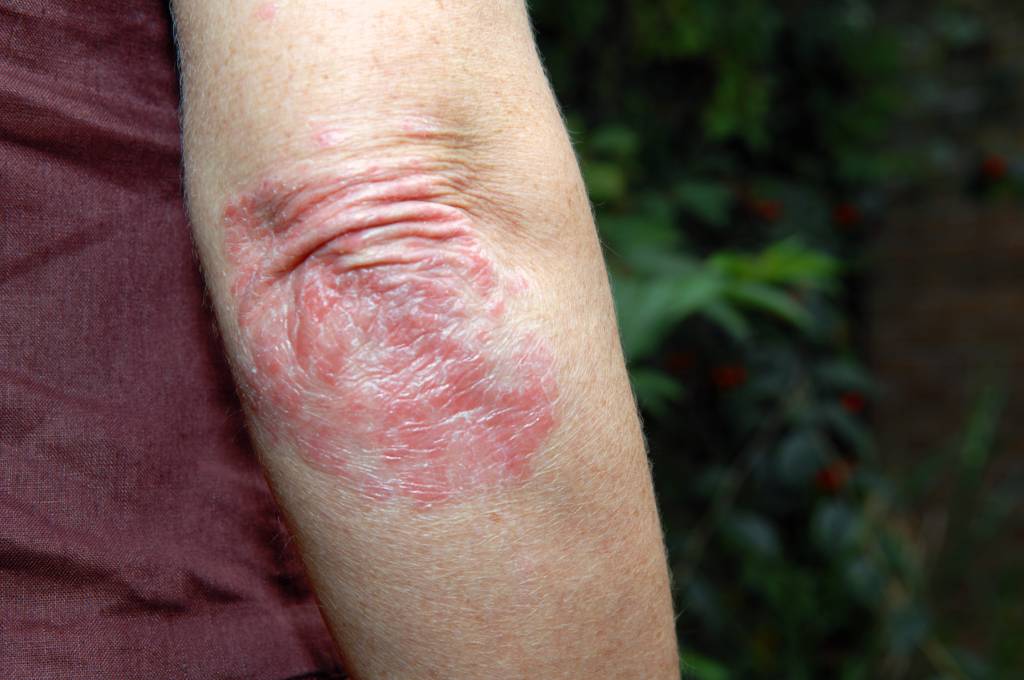Psoriasis is a condition that leaves sufferers embarrassed and frustrated with their skin. Scaly red spots, silvery patches, and constant discomfort are just a few of its effects – and although psoriasis isn’t contagious, its cause is unknown, leaving sufferers struggling with their symptoms.
If you’re looking for a psoriasis treatment that actually works, you’re likely wondering if you’ll ever find relief. Fortunately, new medical advances and technologies are making psoriasis treatment better than ever before. From laser therapy to biologics to steroids, here’s what you need to know about the latest treatment options for psoriasis.
 The Newest Option: XTRAC Laser Therapy
The Newest Option: XTRAC Laser Therapy
Phototherapy, also known as light therapy, is the use of ultraviolet light for healing different ailments. While different types of phototherapy have been used for years to alleviate the symptoms of psoriasis, one new approach is making waves: XTRAC laser therapy.
This new phototherapy uses a laser unlike any other. The XTRAC laser, a small, hand-held device that dermatologists can use in the office, works quickly so psoriasis sufferers see faster, more satisfactory results. The XTRAC laser delivers high-intensity UV light in repetitive pulses and is focused on localized areas to target specific symptoms or problem areas. It’s so exact that the laser beam never touches the surrounding skin.
A single XTRAC treatment can significantly reduce large patches of psoriasis. The specific length of treatment and laser dosage is based on the type of psoriasis you have, the thickness of your lesions, and your skin type. Lower doses are prescribed for fair-skinned patients. Dermatologists typically recommend multiple treatments, and adjustments may be made if you experience side effects.
XTRAC laser treatments take just a few minutes, and they aren’t painful. You may feel slight warmth in the area being treated or feel a sensation of something tapping against your skin. Your doctor will give you goggles to protect your eyes.
XTRAC therapy is usually effective for all five types of psoriasis. In a 2002 study, Healthline¹ reports more than 70 percent of participants saw at least 75 percent improvement after an average of six treatments. About half had a 90 percent reduction of their psoriasis after 10 or fewer treatments. Since this method is relatively new, more studies are needed to evaluate long-term results and safety.
It’s important to note that psoriasis is chronic. There is no cure to date, and the fundamental autoimmune problem that causes T cells to overproduce has not yet been discovered. However, XTRAC therapy is shown to reduce the severity and duration of flare-ups. Like other chronic diseases, psoriasis can be managed with continued treatment.
Benefits of XTRAC Laser Therapy
More than four million Americans have undergone XTRAC treatments. There are numerous benefits:
- Fast, pain-free treatment
- Can be used on any area of the body
- Reduced symptoms in as little as four weeks
- Several symptom-free months following a treatment regimen
- No downtime after treatment
- No messy topical creams
- No drugs
If you’re at all worried about XTRAC laser therapy as a new psoriasis treatment option, it’s medically sound. The American Academy of Dermatology has endorsed XTRAC laser therapy for children and adults with psoriasis that covers less than 10 percent of the body, and it was approved by the FDA in 2000 according to Medical News Today².
Drawbacks and Side Effects
The biggest drawback of this phototherapy treatment is the time commitment. Repeated treatments are required for best results, so getting one session won’t alleviate your symptoms or flare ups.
Fortunately, the XTRAC laser treatment has very few side effects – and for most people, any side effects are minimal and temporary. Much depends on the condition of your skin, your skin’s sensitivity to light, and your overall health.
Some possible side effects include:
- A hot sensation or mild, temporary pain during treatment
- Skin redness
- Itching, flaking or peeling skin
- Blisters
- Oozing lesions
- Purplish spots on the skin
- Darkening or lightening of the skin
- Scarring
Thoroughly discuss your health history and current health issues with your dermatologist. Most doctors don’t recommend XTRAC laser therapy for patients who have lupus, scleroderma, or xeroderma pigmentosum, an inherited condition that causes sensitivity to sunlight.
What’s the Cost?
Each XTRAC laser therapy session costs an average $150 according to Zwivel³, but most health insurance companies cover this treatment if it’s considered medically necessary. Some insurance plans will approve XTRAC if other remedies, such as topical creams, haven’t helped your psoriasis.
In short, the cost depends largely on your insurance plan. Your doctor can verify coverage before you schedule appointments. You can also contact the National Psoriasis Foundation if your claims are denied. Their representatives can help you file appeals and even direct you to resources for financial assistance, helping you take advantage of XTRAC laser therapy without significant expense.
Other Treatment Options
If XTRAC laser therapy isn’t for you and your psoriasis, there are other options. In fact, there are even other types of laser treatments to try, like pulsed dye lasers. A study published in the Journal of Dermatological Treatment⁴ concluded that pulsed dye laser is safe, effective and, tolerable for resistant, stable, localized plaque psoriasis. This treatment option has limitations, however, and most doctors favor XTRAC. PDL targets tiny blood vessels while XTRAC attacks T cells with better results.
Biologics are another option. These medications, which are derived from proteins or antibodies in living organisms, are injected into your bloodstream and work against T cells to ease inflammation and prevent the growth of thick, scaly skin.
These drugs are not without drawbacks, though, and side effects can include the following:
- Increased risk of infection and some types of cancer
- Diarrhea
- Nausea
- Headache
- Unwanted weight loss
- Depression
For decades, topical corticosteroids, injected steroids, and oral steroids were used to treat psoriasis. Most doctors are shying away from those now because of potential risks over long-term use. Even mild topical versions can cause permanent thinning of the skin. Prolonged use around the eyes could trigger cataracts or glaucoma.
Oral and injected steroids used long term can cause serious conditions like diabetes, obesity, osteoporosis, hypertension, and heart disease. Stopping them suddenly is downright painful and potentially dangerous.
Some promising studies have suggested that maintaining a healthy pH balance works wonders for psoriasis, but results are largely inconclusive.
Until scientists land on the root cause in the immune system, finding relief can be a challenge. Still, developments like XTRAC laser therapy give you every reason to be hopeful. New medications or cutting-edge technology for managing psoriasis could be just around the corner. Do your homework, and never give up.
Like anything, it’s always a good idea to be aware of the latest research. We recommend comparing at least 3 or 4 options before making a final decision. Doing a search online is typically the quickest, most thorough way to discover all the pros and cons you need to keep in mind.


